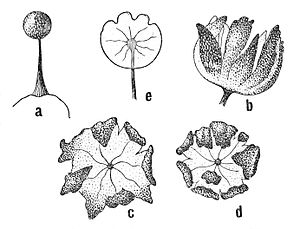Barbeyella minutissima
| Barbeyella minutissima | ||||||||||||
|---|---|---|---|---|---|---|---|---|---|---|---|---|

a) fruiting bodies, b) - e) views of the open peridium |
||||||||||||
| Systematics | ||||||||||||
|
||||||||||||
| Scientific name of the genus | ||||||||||||
| Barbeyella | ||||||||||||
| Meyl. | ||||||||||||
| Scientific name of the species | ||||||||||||
| Barbeyella minutissima | ||||||||||||
| Meyl. |
Barbeyella minutissima is a species of slime mold from the order of the Echinosteliida and the only species of the genus Barbeyella . Its range is limited to the northern hemisphere, it often settles on mosses. The species is one of the smallest representatives of the Myxogastria and is considered rare.
features
The protoplasmodium is colorless and transparent, the fruiting bodies arise from hemispherical protoplasm masses, which measure approximately 1.5 times the diameter of the mature sporangia . As it matures, dark spots appear, and later the center of the protoplasm becomes dark. The still translucent, milk-white protoplasm then rises up the stalk, where first the capillitium and peridium and finally the spores are formed. This process took about a day at room temperature.
The long-stalked, black-brown or black-violet, barely shiny sporangia of Barbeyella are spherical, they measure 0.15 to 0.2 millimeters in diameter and are 0.3 to 0.7 millimeters long including the stem. They are mostly scattered, but often also in loose, large colonies. The hypothallus has a diameter of 0.7 millimeters and cannot be seen on mosses, but is red-brown on wood. The brown-black stalk is thickened up to 0.1 millimeter towards the base and tapers up to 5 micrometers, it is filled with protoplasmic waste material. The columella , which arises from the tip of the stem, ends at its upper end about halfway up the fructification in seven to thirteen simple or rarely bifurcated, 1 to 4 micrometers in diameter, dark brown capillary filaments. These are taut, usually individually, rarely in pairs, fused with the lobed, elongated, round sections of the peridium, into which the sporangium tears from above against the base to ripen the spores. This adhesion prevents the peridial lobes from breaking off and distributes the spores over a longer period of time, similar to a pore capsule . The peridia are covered with plasmatic granulations upwards, but almost free of them towards the bottom. Depending on the size of the plasmatic granulations, the peridia appears papillous or smooth.
The spores are black-brown in mass, brown in transmitted light . They are sculpted warty, rarely almost smooth and have a diameter of 7 to 9 micrometers.
distribution
Barbeyella minutissima is considered rare. Their distribution follows the montane spruce and fir forests in the northern hemisphere. It is limited to altitudes between 500 and 2500 meters, occasionally descending to sea level or ascending to 3500 meters. So far it has been found in Europe (Finland, Germany, Switzerland, Poland, Romania), in western and eastern North America (Washington, Oregon, California, Mexico or North and South Carolina and Virginia), in the Indian Himalayas and in Japan.
ecology
The species settles exclusively in habitats of slightly to severely rotted and barkless dead wood in coniferous forests in cool, moist environments. 40 to 100% of the wood is overgrown with liverworts , especially of the Nowellia and Cephalozia genera . Nowellia curvifolia in particular is regarded as an indicator of the species. As an alternative to mosses, it is also found in association with unicellular algae, it is assumed that the protoplasmodium phagocytoses either the algae or the bacteria living on them . In addition, other types of Myxogastria are often found together with Barbeyella , in particular Lepidoderma tigrinum , Lamproderma columbinum and Colloderma oculatum .
Systematics and research history
The species was first described in 1914 by Charles Meylan based on a specimen from the Swiss Jura . The generic name honors the Swiss botanist William Barbey (1842–1914). Together with the genus Clastoderma , it forms the family of the Clastodermidae .
proof
Footnotes directly behind a statement cover the individual statement, footnotes directly behind a punctuation mark the entire preceding sentence. Footnotes after a space refer to the entire preceding paragraph.
- ↑ a b c d e Martin Schnittler, Steven L. Stephenson, Yuri K. Novozhilov: Ecology and world distribution of Barbeyella minutissima (Myxomycetes). In: Mycological Research, Vol. 104, 2000, p. 1518.
- ^ A b c d Hermann Neubert , Wolfgang Nowotny , Karlheinz Baumann : The Myxomycetes of Germany and the neighboring Alpine region with special consideration of Austria . tape 1 . Karlheinz Baumann Verlag, Gomaringen 1993, ISBN 3-929822-00-8 , p. 46-47 .
- ↑ a b c Hans Schinz: Myxogasteres (Myxomycetes, Mycetozoa). In: Dr. L. Rabenhorst's Kryptogam-Flora von Deutschland, Oesterreich und der Schweiz , Vol. 1 ( Die Pilze Deutschlands, Oesterreichs ud Switzerland with consideration of the other countries of Europe ), Part 10, 1920, pp 408-410.
- ↑ Michael J. Dykstra, Harold W. Keller: Mycetozoa. In: John J. Lee, GF Leedale, P. Bradbury (Eds.): An Illustrated Guide to the Protozoa . tape 2 . Allen, Lawrence 2000, ISBN 1-891276-23-9 , pp. 965 .